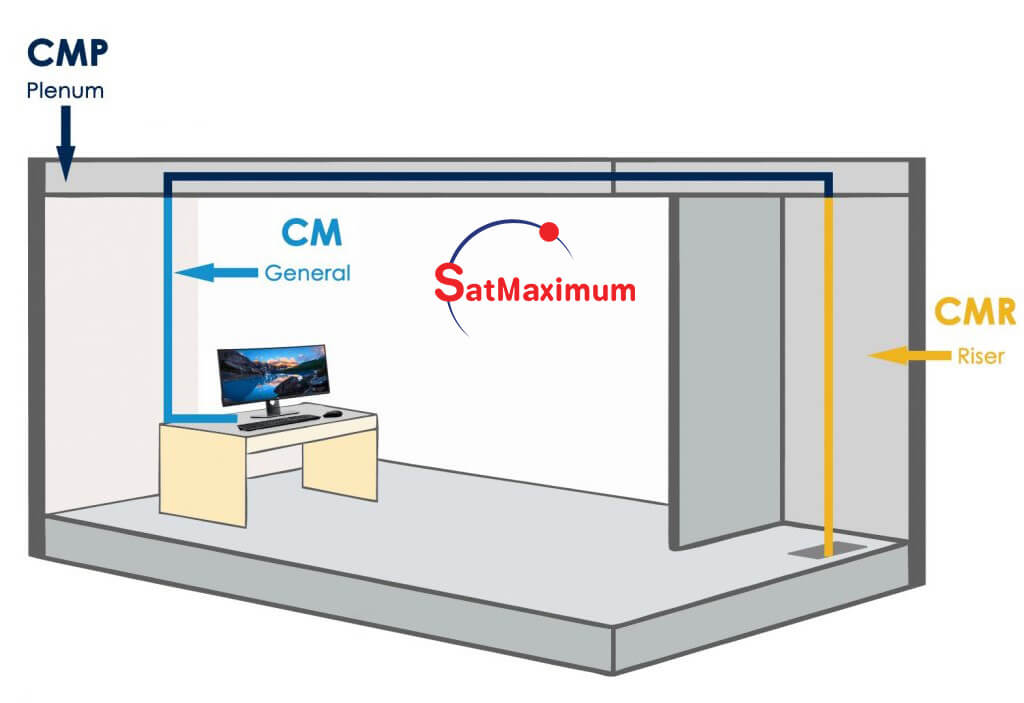Riser vs Plenum Cable
When comparing riser vs plenum cables, we will discover that both of these cables clearly have their own significant traits for their area of application. In this article we will give a brief comparison on their differences so that it will help you make the right choice for your application.
What Is Riser Cable
A Riser cable is an Ethernet cable designated for installation in non-plenum spaces within a riser or vertical cable pathway. These pathways can be between each floor, in an elevator shaft or any other vertical channel. Its PVC jacket is comprised of flame-retardant compounds that helps protect the cable against the risk of fire hazards and higher temperatures in vertical rising spaces. It is approved for installation in non-plenum spaces according to the guidelines given by the National Fire Protection Association (NFPA) and National Electric Code (NEC).
What Is Plenum Cable
A Plenum cable is an Ethernet cable that is specifically rated for installation in plenum spaces such as; HVAC ducts, drop ceilings or raised floor systems. All plenum cables have an outer jacket made of compounds that have the highest fire-resistant rating and adhere to stricter regulations from the National Fire Protection Association (NFPA). Learn more about Plenum cables here: What Is Plenum Cable
Differences Between Riser Cable and Plenum Cable
When it comes to discussing riser cable (or non-plenum) and plenum cable, it’s all about the fire resistance of the cable jacket. Understanding the difference between the two will determine the standard of cable you need to use for your application.
Riser cable jackets is manufactured with less fire-resistant compounds than a plenum cable, however, it is still rated safer than general purpose cables. For these reasons, the riser cable is less expensive than a plenum cable
As far as plenum cables go, its jacket has greater fire-resistant compounds. These compounds make them highly durable, emit lower toxic fumes and promote a lower risk of electrical fire than riser cables. Because of this, plenum cables are typically more expensive.
According to the National Fire Protection Association (NFPA) which outlines the standards for electrical wiring in buildings in the National Electric Code (NEC) guidelines, their primary purpose is to prevent fires in plenum and non-plenum spaces. Nearly all state governments and local cities have adopted NEC guidelines as a major part of the building codes. These guidelines are there to protect you and the occupants of the building. For this reason, it is vitally important to understand the differences of each cable before installation.
Here are the standards for the three most commonly used “Communications Multipurpose” (CM) cables listed in the NEC guidelines:
| CMP PLenum | CMR Riser | CM Standard | |
|---|---|---|---|
| Fire-resistance rating | Highest | Less | Least |
| Space | Plenum / air ducts/ any location | Risers / vertical applications / non-riser spaces | General use / can be used in walls and beneath floors or other areas without fire code restrictions |
| Jacket | Low-Smoke PVC or FEP compounds | Flame Retardant PVC | PVC |
| Levels of toxic fumes | Low | High | High |
| Price | $$$ | $$ | $ |
Plenum vs Riser Spaces

Where To Use Riser Cable
Riser cable is primarily installed in residential settings, but can be used in commercial settings as well. It is typically used for voice, data and video applications that are installed in non-plenum spaces. Non-plenum spaces examples: inside the walls, between floors, or along the floor of the building.
Where To Use Plenum Cable
Almost all building codes today require the use of plenum-rated cable in all plenum spaces and air ducts. This is particularly true in larger public buildings like hospitals, schools, airports, etc. where the fire safety regulations are extremely strict. Because of the higher occupancy in those type of locations, building codes in some cities and towns will only allow the use of plenum cable even in non-plenum spaces.
Can I Use Riser In Plenum Spaces And Vice Versa
According to the strict regulations given by the NFPA and NEC, a riser cable cannot be used in plenum spaces. This is because the riser cable is not fire-rated for plenum spaces. You can substitute plenum cables in place of riser cables in a riser-designated space, but you cannot substitute plenum cables with riser cables in a plenum-designated space.
Conclusion:
We hope this article was informative and that it gave you a better understanding of riser cables vs plenum cables. If you are still unsure which cable to install, you should contact your local building department to find out the exact building and fire codes. Not doing so could prove very expensive in the long run.













































